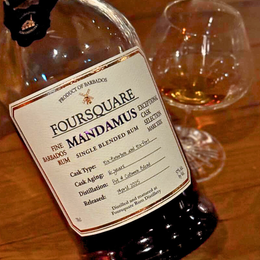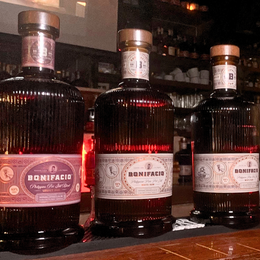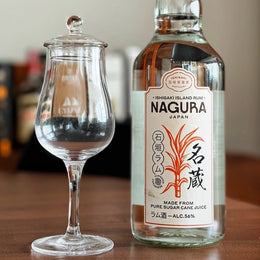
Okinawa's OneRum has been something I've been very eager to try for awhile now, although I've been relegated to only largely having seen it on Instagram, along with its small output, being in high demand, as well as limited distribution only within Japan.
The Okinawan brown sugar based white rum is the brainchild of Akira Nakazato, who is the Master Distiller of Mizuho Shuzo, the second oldest Awamori distiller in Okinawa. Whilst rum-making has certainly become more popular in Okinawa, unsurprising considering that sugarcane is the largest crop by acreage in the chain of islands, there are few producers whose sole focus is to distill cane spirits - most of them being involved in the sugar trade in one way or the other. Okinawa not only produces the common table white sugar, it also produces a more prized brown sugar - often marketed as Okinawan Black Sugar - that is toffee-like, earthy and caramel tasting, and is even touted to have medicinal benefits. And thus the sugar trade is a big part of the Okinawan economy.


Akira Nakazato of Mizuho Shuzo.
But going back to the realm of alcoholic spirits, another reason rum isn't as popular as a primary output of distilling is because Okinawa is far more popular for a rice spirit known as Awamori. Awamori is a traditional spirit that's been produced in Okinawa for over 400 years, and is a legacy from a time when Okinawa (then known as the Ryukyu Kingdom) was a major trading hub with East Asian countries such as the Ayutthaya Kingdom (modern day Thailand).
Very uniquely Awamori is only made of long grain indica rice which Okinawa imports from Thailand where it is primarily grown (meaning Okinawa's native spirit's base ingredient is almost exogenous and thus the part about Awamori that is Okinawan is the process and not the ingredient). Indeed the know-how to do with producing Awamori comes from a similar Thai spirit known as lao khao which the Okinawans have since modified in terms of how it is made which is what makes it Awamori.

So taking stock of what the landscape, we've got locally treasured rice spirit known as Awamori but also lots of sugarcane that is used to produce sugar. The only issue then has been that Awamori has for awhile now found it difficult to stay relevant with younger consumers, and when Covid hit, Okinawan brown sugar was piling up in warehouses. It was then time for Nakazato to step in and link up the two - he would produce rum, which was also fast gaining in popularity, from the brown sugar using his distilling experience, this would become OneRum.
Yet, he was perceptive to take it a step further considering his understanding that each of Okinawa's islands had its own unique terroir, microclimate and process in producing brown sugar (Iheya island's brown sugar is said to be cleaner, whilst Hateruma island's brown sugar is said to be earthier). And so OneRum's first lineup was a series of 8 white rums each made from the brown sugar sourced from one of eight Okinawa islands - this would be the OneRum Single Island series. This idea of exploring Okinawa's various islands each with its own style of rum reminded Nakazato of the Caribbeans where rum is most popularly from, and as he points out, shares a similar latitude with Okinawa.

Each of the Single Island rum would don a vibrant and artisanal label with art that points at what its respective island is known for, be it wildlife, flora or cultural practice and myths. The Iriomote Island Rum features the Iriomote wild cat which is a beloved and unique wildlife on the island which itself was recognised as an UNESCO World Natural Heritage Site for its biodiversity. Meanwhile the Tarama Island Rum features locals dressed up for the Hachigatsu Odori harvest festival that takes place every year in August on the island.
Ultimately, Nakazato's hope is to elevate Okinawa's place in the world of alcoholic spirits be it through Awamori or perhaps through rum. It seems he has a deep conviction at the diversity and quality of Okinawa's produce and will find the necessary form to showcasing it to the world. More recently he's announced the future release of an agricultural rum that will use sugarcane juice harvested from sugarcane grown by Nakazato himself - which he has been learning to grow - from Mizuho Shuzo's plot! His hope is to produce something along the lines of the French-style Rhum Agricole.

Thus far I've not had the benefit of trying the Single Island series as they've numbered only in the hundreds of bottles (actually limited) and have been incredibly popular in Japan and thus distribution has been largely local.
Nevertheless at a local Sake festival, Sake Matsuri, that took place in early May 2024, I did spot the latest release from OneRum, which is the Okinawa Islands Rum - Blended, which sees the eight Single Island white rums blended into one, which would symbolically showcase what Okinawa is all about.
Incredibly excited to try this! Let's go!
The Okinawa Islands Rum Blended, OneRum, 40% ABV | 沖縄アイランズ ラム ブレンデッド ONERUM 瑞穂酒造 - Review

Tasting Notes
Color: Clear
Aroma: Readily vibrant tropical scents - an incredibly aromatic mix of florals and tropical fruits of papaya, pineapple, mangosteen. The fresh floral bouquet ranges from an assortment of green and white florals - perhaps a tropical fruit blossom. Very gently there’s a light cane syrup sweetness and richness.
Taste: Medium bodied here but candied sweet - fondant, candy corn, as well as some banana blossoms. It narrows and intensifies here, yet keeps its cohesiveness. It’s definitely punchier here and more defined. It’s full of power and vigour, really focused and firm too.
Finish: More on cane concentrate, with those tropical fruits flowing back in - especially the papaya. Peppery, more cane massaged into fondant. Also lightly dry, with more of that floral and lightly vegetal banana blossom. It mellows out to a lingering coat of brown sugar, with a light savouriness.

My Thoughts
An incredibly fascinating white rum! This has an incredible complexity that’s given loads of intensity and dynamism - it ebbs and flows, at times slowly blossoming whilst in other instances it’s moving rapidly. It flavours vacillate between opening up softly like flower petals, yet also demonstrates the ability to focus and firm up to an incredibly well-defined and powerful narrower spread of flavours. All throughout, the flavours are powerful yet not overpowering, they always feel intentional, and are ridiculously vibrant.
And that’s all viewing it with the lens of a microscope, yet taking a step back, it somehow retains its cohesiveness - nothing ever feels out of place or disjointed. It almost feels like a theatrical play that I’m at - though its worth pointing out that this isn’t some jumble of random things going on at the same time. Rather it is evolving at it progresses, demonstrating various capabilities, which is really what makes it so incredibly impressive. And while white rums are themselves fully able to express complexity, I can’t help but find myself curious as to what this would be like aged.
It’s also worth noting that this doesn’t pack much in the way of heat, sharpness or any form of synthetical sort of chemical qualities, it’s not high toned a la varnish - rather it’s got a mellowness and richness, which is not something you immediately think of because there’s like so much else that’s even more impressive that’s going on - but the point here is that, if this is indeed going to be aged, I don’t foresee any drop off in terms of it losing much in the way of any intensity and punchiness, which is an oft critique of higher ester white rums being aged, which sometimes feels blunted. I actually think this might work!
I hope in time I’ll be able to find the individual island rums and hopefully see an aged version of this. But till then, this was quite possibly one of the most impressive white rums I’ve had - vibrant, dynamic, mellow, and what everyone wants to hear, super tropical fruit forward.
Kanpai!

@111hotpot







